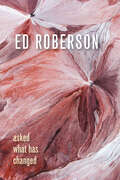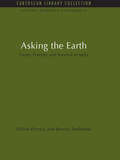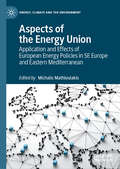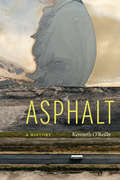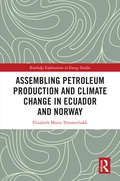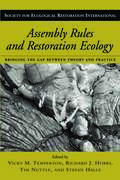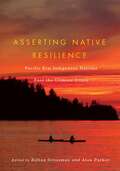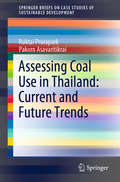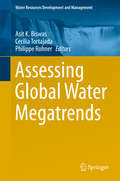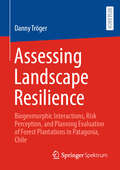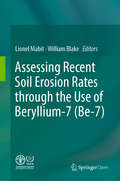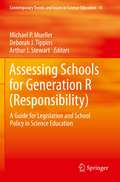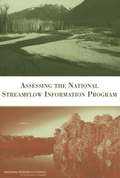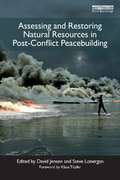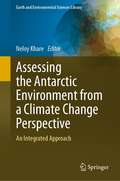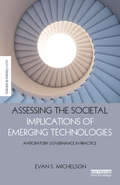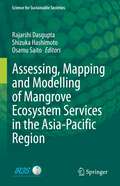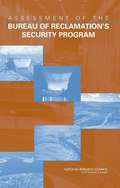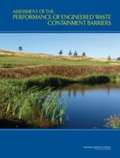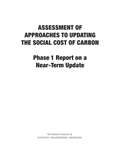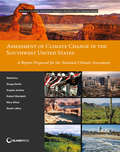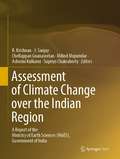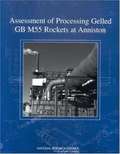- Table View
- List View
Asked What Has Changed (Wesleyan Poetry Series)
by Ed RobersonA Black ecopoet observes the changing world from a high-rise window, &“ever alert to affinities between the small and the vast, the fleeting and the cosmic&” (James Gibbons, Hyperallergic). Award-winning poet Ed Roberson confronts the realities of an era in which the fate of humanity and the very survival of our planet are uncertain. Departing from the traditional nature poem, Roberson's work reclaims a much older tradition, drawing into poetry&’s orbit what the physical and human sciences reveal about the state of a changing world. These poems test how far the lyric can go as an answer to our crisis, even calling into question poetic form itself. Reflections on the natural world and moments of personal interiority are interwoven with images of urbanscapes, environmental crises, and political instabilities. These poems speak life and truth to modernity in all its complexity. Throughout, Roberson takes up the ancient spiritual concern—the ephemerality of life—and gives us a new language to process the feeling of living in a century on the brink.
Asking the Earth: Farms, Forestry and Survival in India (Natural Resource Management Set)
by Jeremy Seabrook Winin PereiraThe need to produce food without the destructive chemical horrors of much modern farming, for an intelligent use of dwindling natural resources and for humane forms of production is universal, the practice is limited. This book is an account of one, large, instance of success in practice. Twenty-five years ago, Winin Pereira, a nuclear physicist abandoned academia to start a co-operative farm at Alonde in a tribal area north of Bombay. The group experienced, and finally discarded, all the false hopes and promises of Western originated forms of development: ploughs that ploughed too deep, irrigation systems that lowered water tables, fertilizers and pesticides which managed the earth and became so expensive that poorer farmers were dispossessed. Instead they learnt from the adivasai, or tribal people, who have nurtured or been nurtured by foresets for millennia, ways of applying popular knowledge to contemporary problems. This book is a combination of Pereira's record of achievement of sustainable livelihoods and an account of the farm and its effect on the India around it by a leading British journalist. Originally published in 1991
Aspects of Brazilian Floristic Diversity: From Botany to Traditional Communities
by Maria Franco Trindade Medeiros Bárbara de Sá HaiadAspects of Brazilian Floristic Diversity: From Botany to Traditional Communities offers a unique approach in floristic diversity of the Neotropical region, specifically encompassing the Brazilian flora. This volume combines both theoretical and applied aspects of scientific making knowledge in different perspectives of Botanical Science. In this volume, botanical specialists discuss the many different approaches of taxonomic, reproductive, ecological and ethnobotanical aspects of Brazilian floristic diversity, thereby enlightening the global interest in Neotropical species, in particular those from the Brazilian territory. The book addresses relevant questions from many points of view, including anatomy, reproduction, palinology, conservation and ethnobotany, creating an in-depth perception of the flora in its complexity constitution.The book provides a comprehensive outlook on Botany Sciences, considering the history and traditional knowledge of plants, and relating it to contemporary problems and concerns of flora conservation today. With this current perspective, this book reaches a vast audience from the research lines of Botany, and encompasses a broader and interdisciplinary understanding of Aspects of Brazilian Floristic Diversity.
Aspects of the Energy Union: Application and Effects of European Energy Policies in SE Europe and Eastern Mediterranean (Energy, Climate and the Environment)
by Michalis MathioulakisThis book provides a comprehensive exploration of some of the most critical issues regarding the EU’s Energy Union policy. Applied European energy policies face a number of challenges ranging from the geopolitics of energy and energy regulation, to climate change, advancing renewable and gas technologies, and consumer empowerment structures. This book takes a multi-dimensional look into some of these vital issues regarding the European energy sector with a special focus on the effects the Energy Union policy has in two sensitive regional systems, Southeastern Europe and the Eastern Mediterranean.Energy, being by definition a multi-disciplinary field, presents a challenge for readers of any specific disciplinary background that need to grasp an overall understanding of the various aspects of this exciting sector. This book’s objective is to offer the opportunity for readers to get a quality, hands-on overview of the Energy Union by the professionals and academics that interact with it on a daily basis.
Asphalt: A History
by Kenneth O'ReillyLa Brea Tar Pits once trapped prehistoric mammals. Today that killer has a chemical cousin in the Athabasca oil sands of Alberta, Canada—immense deposits of natural asphalt destined for upgrading to synthetic crude oil. If the harvesting of this natural asphalt continues unabated, we might find ourselves stuck in a muck of a different kind. Humanity has used asphalt for thousands of years. This humble hydrocarbon may have glued the first arrowhead to the first shaft, but the changes wrought by this material are most dramatic since its emergence as pavement. Since the 1920s the automobile and blacktop have allowed unprecedented numbers of Americans to experience the beauty of their continent from the Adirondacks to the Rockies and beyond, to Big Sur and the Pacific Coast Highway. Blacktop roads, runways, and parking lots constitute the central arteries of our environment, creating a distinct &“political territory&” and a &“political economy of velocity.&” In Asphalt: A History Kenneth O&’Reilly provides a history of this everyday substance. By tracing the history of asphalt—in both its natural and processed forms—from ancient times to the present, O&’Reilly sets out to identify its importance within various contexts of human society and culture. Although O&’Reilly argues that asphalt creates our environment, he believes it also eventually threatens it. Looking at its role in economics, politics, and global warming, O&’Reilly explores asphalt&’s contribution to the history, and future, of America and the world.
Assembling Petroleum Production and Climate Change in Ecuador and Norway (Routledge Explorations in Energy Studies)
by Elisabeth Marta TómmerbakkThis book addresses some of the controversies and uncertainties associated with reducing the extensive exploitation of fossil fuels due to their role in global warming. Elisabeth Marta Tómmerbakk explores why a transition towards a post-carbon society is so difficult to accomplish by examining how the relationship between petroleum production and climate change is politically framed and negotiated in contested cases. This question is approached through a process-oriented comparative case study of Lofoten, located in the Norwegian Sea above the Arctic Circle, and Yasuní-ITT (Ishpingo, Tambococha, and Tiputini) located in the Ecuadorian Amazon: regions that both belong to oil-exporting countries with highly oil-dependent economies. Tómmerbakk draws on rich empirical data that includes qualitative interviews with subjects in both countries and applies an Actor-Network Theory framework to show that oil and climate are intricately entangled in knowledge and policy practices. Overall, Assembling Petroleum Production and Climate Change in Ecuador and Norway provides an in-depth examination of how climate science and petroleum extraction are negotiated, adapted, assembled, and coordinated with other national policies and political aims. This book will be of great interest to students and scholars of petroleum production, climate change, environmental policy, and environmental sociology.
Assembly Rules and Restoration Ecology: Bridging the Gap Between Theory and Practice (Science Practice Ecological Restoration #5)
by Richard J. Hobbs Vicky M. Temperton Tim Nuttle Stefan HalleUnderstanding how ecosystems are assembled -- how the species that make up a particular biological community arrive in an area, survive, and interact with other species -- is key to successfully restoring degraded ecosystems. Yet little attention has been paid to the idea of assembly rules in ecological restoration, in both the scientific literature and in on-the-ground restoration efforts. Assembly Rules and Restoration Ecology, edited by Vicky M. Temperton, Richard J. Hobbs, Tim Nuttle, and Stefan Halle, addresses that shortcoming, offering an introduction, overview, and synthesis of the potential role of assembly rules theory in restoration ecology. It brings together information and ideas relating to ecosystem assembly in a restoration context, and includes material from a wide geographic range and a variety of perspectives. Assembly Rules and Restoration Ecology contributes new knowledge and ideas to the subjects of assembly rules and restoration ecology and represents an important summary of the current status of an emerging field. It combines theoretical and practical aspects of restoration, making it a vital compendium of information and ideas for restoration ecologists, professionals, and practitioners.
Asserting Native Resilience: Pacific Rim Indigenous Nations Face the Climate Crisis
by Alan Parker Zoltán GrossmanIndigenous nations are on the front line of the climate crisis. With cultures and economies among the most vulnerable to climate-related catastrophes, Native peoples are developing twenty-first century responses to climate change that serve as a model for Natives and non-Native communities alike. Native American tribes in the Pacific Northwest and Indigenous peoples around the Pacific Rim have already been deeply affected by droughts, flooding, reduced glaciers and snowmelts, seasonal shifts in winds and storms, and the northward movement of species on the land and in the ocean. Using tools of resilience, Native peoples are creating defenses to strengthen their communities, mitigate losses, and adapt where possible. Asserting Native Resilience presents a rich variety of perspectives on Indigenous responses to the climate crisis, reflecting the voices of more than twenty contributors, including tribal leaders, scientists, scholars, and activists from the Pacific Northwest, British Columbia, Alaska, and Aotearoa / New Zealand, and beyond. Also included is a resource directory of Indigenous governments, NGOs, and communities and a community organizing booklet for use by Northwest tribes.
Assessing Coal Use in Thailand: Current and Future Trends (SpringerBriefs on Case Studies of Sustainable Development)
by Ruktai Prurapark Pakorn AsavaritikraiThis book highlights Thailand’s growing demand for clean energy from coal. The main source of energy for electricity production in Thailand (70%) is currently natural gas. However, natural gas extraction remains limited, resulting in an increasing need to import natural gas from other countries, which in turn leads to rising prices and unstable supplies. As such, coal energy is essential for industrial use and electricity production in Thailand. The book discusses the importance of developing and implementing clean technologies for coal. It also argues that collaborations between the government, private sector and the public are vital to achieving a mutual understanding and acceptance of coal energy and clean technologies, as well as a reduction in harmful emissions.
Assessing Global Water Megatrends (Water Resources Development and Management)
by Asit K. Biswas Cecilia Tortajada Philippe RohnerThis book highlights what are likely to be the future megatrends in the water sector and why and how they should be incorporated to improve water governance in the coming decades. In this first ever book on megatrends for the water sector, 22 leading world experts from different disciplines representing academia, business, government, national and international organisations discuss what the major megatrends of the future are and how they will radically change water governance in the coming decades.
Assessing Landscape Resilience: Biogeomorphic Interactions, Risk Perception, and Planning Evaluation of Forest Plantations in Patagonia, Chile
by Danny TrögerThis book examines the extent to which exotic pine plantations are a suitable strategy for maintaining the essential functions, structures, processes and identity of the Patagonian landscape over time. To this end, it integrates three empirical studies with inter- and transdisciplinary approaches under the theoretical framework of landscape resilience. The first study analyses the biogeomorphic interactions of different land uses and their relevance for soil conservation and landslide mitigation. The second study examines perceptions of natural hazards and focuses on networks of human and non-human actors that maintain landscape resilience. The results of these two studies are incorporated into the planning evaluation of land zoning and alternative strategies are developed, inspired by normative polycentric governance. It is concluded that Pinus plantations partially fulfil their ecological objectives of erosion control and landslide mitigation. However, their performance lags behind that of secondary forests with native species and they create new risks such as reduced biodiversity, increased risk of wildfires and conflicts with local identity. The book concludes with new research questions of trans-regional importance.
Assessing Recent Soil Erosion Rates through the Use of Beryllium-7 (Be-7)
by William Blake Lionel MabitThis open access book is the first comprehensive guideline for the beryllium-7 (Be-7) technique that can be applied to evaluate short-term patterns and budgets of soil redistribution in agricultural landscapes. While covering the fundamental and basic concepts of the approach, this book distinguishes itself from other publications by offering step-by-step instructions on how to use this isotopic technique effectively. It covers experimental design considerations and clear instruction is given on data processing. As accurate laboratory measurement is crucial to ensure successful use of Be-7 to investigate soil erosion, a full chapter is devoted to its specific determination by gamma spectrometry. This open access contribution further describes new developments in the Be-7 technique and includes a concluding chapter highlighting its potential benefits to support the implementation of area-wide soil conservation policy.
Assessing Schools for Generation R: A Guide for Legislation and School Policy in Science Education (Contemporary Trends and Issues in Science Education #41)
by Michael P. Mueller Deborah J. Tippins Arthur J. StewartToday's youth will face global environmental changes, as well as complex personal and social challenges. To address these issues this collection of essays provides vital insights on how science education can be designed to better engage students and help them solve important problems in the world around them. Assessing Schools for Generation R (Responsibility) includes theories, research, and practices for envisioning how science and environmental education can promote personal, social, and civic responsibility. It brings together inspiring stories, creative practices, and theoretical work to make the case that science education can be reformed so that students learn to meaningfully apply the concepts they learn in science classes across America and grow into civically engaged citizens. The book calls for a curriculum that equips students with the knowledge, skills, attitudes and values to confront the complex and often ill-defined socioscientific issues of daily life. The authors are all experienced educators and top experts in the fields of science and environmental education, ecology, experiential education, educational philosophy, policy and history. They examine what has to happen in the domains of teacher preparation and public education to effect a transition of the youth of America. This exciting, informative, sophisticated and sometimes provocative book will stimulate much debate about the future direction of science education in America, and the rest of the world. It is ideal reading for all school superintendents, deans, faculty, and policymakers looking for a way to implement a curriculum that helps builds students into responsible and engaged citizens.
Assessing The National Streamflow Information Program
by Committee on Review of the USGS National Streamflow Information ProgramFrom warning the public of impending floods to settling legal arguments over water rights, the measurement of streamflow (“streamgaging”) plays a vital role in our society. Having good information about how much water is moving through our streams helps provide citizens with drinking water during droughts, control water pollution, and protect wildlife along our stream corridors. The U.S. Geological Survey’s (USGS) streamgaging program provides such information to a wide variety of users interested in human safety, recreation, water quality, habitat, industry, agriculture, and other topics. For regional and national scale streamflow information needs, the USGS has created a National Streamflow Information Program (NSIP). In addition to streamgaging, the USGS envisions intensive data collection during floods and droughts, national assessments of streamflow characteristics, enhanced information delivery, and methods development and research. The overall goals of the program are to: meet legal and treaty obligations on interstate and international waters, support flow forecasting; measure river basin outflows, monitor sentinel watersheds for long-term trends in natural flows, and measure flows for water quality needs. But are these the right topics to collect data on? Or is the USGS on the wrong track? In general, the book is supportive of the design and content of NSIP, including its goals and methodology for choosing stream gages for inclusion in the program. It sees the ultimate goal of NSIP as developing the ability to use existing data-gathering sites to generate streamflow information with quantitative confidence limits at any location in the nation. It is just as important to have good measurements during droughts as during floods, and it therefore recommends supporting Natural Resource Conservation Service forecast sites in addition to those of the National Weather Service.
Assessing and Restoring Natural Resources In Post-Conflict Peacebuilding: Assessing And Restoring Natural Resources In Post-conflict Peacebuilding (Post-Conflict Peacebuilding and Natural Resource Management)
by David Jensen Steve LonerganWhen a country emerges from violent conflict, the management of the environment and natural resources has important implications for short-term peacebuilding and long-term stability, particularly if natural resources were a factor in the conflict, play a major role in the national economy, or broadly support livelihoods. Only recently, however, have the assessment, harnessing, and restoration of the natural resource base become essential components of postconflict peacebuilding. This book, by thirty-five authors, examines the experiences of more than twenty countries and territories in assessing post-conflict environmental damage and natural resource degradation and their implications for human health, livelihoods, and security. The book also illustrates how an understanding of both the risks and opportunities associated with natural resources can help decision makers manage natural resources in ways that create jobs, sustain livelihoods, and contribute to economic recovery and reconciliation, without creating new grievances or significant environmental degradation. Finally, the book offers lessons from the remediation of environmental hot spots, restoration of damaged ecosystems, and reconstruction of the environmental services and infrastructure necessary for a sustainable peace. Assessing and Restoring Natural Resources in Post-Conflict Peacebuilding is part of a global initiative to identify and analyze lessons in post-conflict peacebuilding and natural resource management. The project has generated six books of case studies and analyses, with contributions by practitioners, policy makers, and researchers. Other books address highvalue resources, land, water, livelihoods, and governance.
Assessing the Antarctic Environment from a Climate Change Perspective: An Integrated Approach (Earth and Environmental Sciences Library)
by Neloy KhareThe present book covers diversified contributions addressing the impact of climate change on the Antarctic environment. It covers the reconstruction of environmental changes using different proxies. The chapters focus on the glacial history, glacial geomorphology, sedimentology, and geochemistry of Antarctic region. Furthermore, the Cenozoic evolution of the Antarctic ice sheet is discussed along with a Scientometrics analysis of climate change research. The book serves as a useful reference for researchers who are fascinated by the polar region and environmental research.
Assessing the Requirements for Sustained Ocean Color Research and Operations
by Committee on the Assessment of Ongoing Efforts in the Treatment of Posttraumatic Stress DisorderThe ocean is a fundamental component of the earth's biosphere. It covers roughly 70 percent of Earth's surface and plays a pivotal role in the cycling of life's building blocks, such as nitrogen, carbon, oxygen, and sulfur. The ocean also contributes to regulating the climate system. Most of the primary producers in the ocean comprise of microscopic plants and some bacteria; and these photosynthetic organisms (phytoplankton) form the base of the ocean's food web. Monitoring the health of the ocean and its productivity is critical to understanding and managing the ocean's essential functions and living resources. Because the ocean is so vast and difficult for humans to explore, satellite remote sensing of ocean color is currently the only way to observe and monitor the biological state of the surface ocean globally on time scales of days to decades. Ocean color measurements reveal a wealth of ecologically important characteristics including: chlorophyll concentration, the rate of phytoplankton photosynthesis, sediment transport, dispersion of pollutants, and responses of oceanic biota to long-term climate changes. Continuity of satellite ocean color data and associated climate research products are presently at significant risk for the U.S. ocean color community. Assessing Requirements for Sustained Ocean Color Research and Operations aims to identify the ocean color data needs for a broad range of end users, develop a consensus for the minimum requirements, and outline options to meet these needs on a sustained basis. The report assesses lessons learned in global ocean color remote sensing from the SeaWiFS/MODIS era to guide planning for acquisition of future global ocean color radiance data to support U.S. research and operational needs.
Assessing the Societal Implications of Emerging Technologies: Anticipatory governance in practice (The Earthscan Science in Society Series)
by Evan S. MichelsonA growing problem of interest in the field of science and technology policy is that the next generation of innovations is arriving at an accelerating rate, and the governance system is struggling to catch up. Current approaches and institutions for effective technology assessment are ill suited and poorly designed to proactively address the multidimensional, interconnected societal impacts of science and technology advancements that are already taking place and expected to continue over the course of the 21st century. This book offers tangible insights into the strategies deployed by well-known, high-profile organizations involved in anticipating the various societal and policy implications of nanotechnology and synthetic biology. It focuses predominantly on an examination of the practices adopted by the often-cited and uniquely positioned Project on Emerging Nanotechnologies in the United States, as well as being informed by comparisons with a range of institutions also interested in embedding forward-looking perspectives in their respective area of innovation. The book lays out one of the first actionable roadmaps that other interested stakeholders can follow when working toward institutionalizing anticipatory governance practices throughout the policymaking process.
Assessing, Mapping and Modelling of Mangrove Ecosystem Services in the Asia-Pacific Region (Science for Sustainable Societies)
by Rajarshi Dasgupta Osamu Saito Shizuka HashimotoThis book presents the state-of-the-art of knowledge in assessing, mapping, and modeling mangrove ecosystem services and outlines various scientific tools and techniques, including environmental scenario-building, spatial and econometric modelling to understand the fluctuations and future availability of mangrove ecosystem services. The book also highlights the current gaps and measures in policy planning and outlines the avenues for capacity building. Through case studies and thematic reviews, the book plans to cater to a wide range of audiences, including students, researchers, and decision-makers at various levels involved in mangrove conservation and land use optimization for sustainable and resilient development. This book is particularly useful to researchers and students in the field of landscape and spatial ecology, coastal zone management, ecosystem services, and resilience planning. It is also a must-read for policymakers, conservators, coastal zone managers, foresters, and general administrators in understanding the current and future roles of mangroves in ecosystem-based adaptation through informed decision-making.
Assessment Of The Bureau Of Reclamation's Security Program
by National Research Council of the National AcademiesThe water impounded behind a dam can be used to generate power and to provide water for drinking, irrigation, commerce, industry, and recreation. However, if a dam fails, the water that would be unleashed has the energy and power to cause mass destruction downstream, killing and injuring people and destroying property, agriculture, industry, and local and regional economies. The U.S. Bureau of Reclamation (Reclamation) is responsible for managing and operating some of this nation’s largest and most critical dams. The failure of one or more of these dams as the result of a malicious act would come with little warning and a limited time for evacuation. In the years since the 9/11 attacks, Reclamation has invested significant resources to establish and build a security program. Reclamation is now ready to evaluate the results of these efforts and determine how best to move forward to develop a security program that is robust and sustainable. This book assesses Reclamation’s security program and determines its level of preparedness to deter, respond to, and recover from malicious acts to its physical infrastructure and to the people who use and manage it.
Assessment Of The Performance Of Engineered Waste Containment Barriers
by National Research Council of the National AcademiesPresident Carter’s 1980 declaration of a state of emergency at Love Canal, New York, recognized that residents’ health had been affected by nearby chemical waste sites. The Resource Conservation and Recovery Act, enacted in 1976, ushered in a new era of waste management disposal designed to protect the public from harm. It required that modern waste containment systems use “engineered” barriers designed to isolate hazardous and toxic wastes and prevent them from seeping into the environment. These containment systems are now employed at thousands of waste sites around the United States, and their effectiveness must be continually monitored. Assessment of the Performance of Engineered Waste Containment Barriers assesses the performance of waste containment barriers to date. Existing data suggest that waste containment systems with liners and covers, when constructed and maintained in accordance with current regulations, are performing well thus far. However, they have not been in existence long enough to assess long-term (postclosure) performance, which may extend for hundreds of years. The book makes recommendations on how to improve future assessments and increase confidence in predictions of barrier system performance which will be of interest to policy makers, environmental interest groups, industrial waste producers, and industrial waste management industry.
Assessment of Approaches to Updating the Social Cost of Carbon: Phase 1 Report on a Near-Term Update
by Engineering Medicine National Academies of SciencesThe social cost of carbon (SCC) for a given year is an estimate, in dollars, of the present discounted value of the damage caused by a 1-metric ton increase in CO2 emissions into the atmosphere in that year; or equivalently, the benefits of reducing CO2 emissions by the same amount in that given year. The SCC is intended to provide a comprehensive measure of the monetized value of the net damages from global climate change from an additional unit of CO2, including, but not limited to, changes in net agricultural productivity, energy use, human health effects, and property damages from increased flood risk. Federal agencies use the SCC to value the CO2 emissions impacts of various policies including emission and fuel economy standards for vehicles, regulations of industrial air pollutants from industrial manufacturing, emission standards for power plants and solid waste incineration, and appliance energy efficiency standards. There are significant challenges to estimating a dollar value that reflects all the physical, human, ecological, and economic impacts of climate change. Recognizing that the models and scientific data underlying the SCC estimates evolve and improve over time, the federal government made a commitment to provide regular updates to the estimates. To assist with future revisions of the SCC, the Interagency Working Group on the Social Cost of Carbon (IWG) requested the National Academies of Sciences, Engineering, and Medicine complete a study that assessed the merits and challenges of a limited near-term update to the SCC and of a comprehensive update of the SCC to ensure that the estimates reflect the best available science. This interim report focuses on near-term updates to the SCC estimates.
Assessment of Climate Change in the Southwest United States: A Report Prepared for the National Climate Assessment (NCA Regional Input Reports)
by Gregg Garfin Mary Black Sarah Leroy Angela Jardine Robert MeridethPrepared for the 2013 National Climate Assessment and a landmark study in terms of its breadth and depth of coverage, this report blends the contributions of 120 experts in climate science, economics, ecology, engineering, geography, hydrology, planning, resources management, and other disciplines to provide the most comprehensive, and understandable, analysis to date about climate and its effects on the people and landscapes of Arizona, California, Colorado, Nevada, New Mexico, and Utah--including the U. S. -Mexico border region and the lands of Native Nations. What is the climate of the Southwest like today? What has it been like in the past, and how is it projected to change over the 21st century? How will that affect water resources, ecosystems, agricultural production, energy supply and delivery, transportation, human health, and a host of other areas? How vulnerable is the region to climate change? What else do we need to know about it, and how can we limit its adverse effects?In addressing these and other questions, the book offers decision makers and stakeholders a substantial basis from which to make informed choices that will affect the well-being of the region's inhabitants in the decades to come.
Assessment of Climate Change over the Indian Region: A Report of the Ministry of Earth Sciences (MoES), Government of India
by R. Krishnan J. Sanjay Chellappan Gnanaseelan Milind Mujumdar Ashwini Kulkarni Supriyo ChakrabortyThis open access book discusses the impact of human-induced global climate change on the regional climate and monsoons of the Indian subcontinent, adjoining Indian Ocean and the Himalayas. It documents the regional climate change projections based on the climate models used in the IPCC Fifth Assessment Report (AR5) and climate change modeling studies using the IITM Earth System Model (ESM) and CORDEX South Asia datasets. The IPCC assessment reports, published every 6–7 years, constitute important reference materials for major policy decisions on climate change, adaptation, and mitigation. While the IPCC assessment reports largely provide a global perspective on climate change, the focus on regional climate change aspects is considerably limited. The effects of climate change over the Indian subcontinent involve complex physical processes on different space and time scales, especially given that the mean climate of this region is generally shaped by the Indian monsoon and the unique high-elevation geographical features such as the Himalayas, the Western Ghats, the Tibetan Plateau and the adjoining Indian Ocean, Arabian Sea, and Bay of Bengal. This book also presents policy relevant information based on robust scientific analysis and assessments of the observed and projected future climate change over the Indian region.
Assessment of Processing Gelled GB M55 Rockets at Anniston
by Committee on Review of Army Planning for the Disposal of M55 Rockets at the Anniston Chemical Agent Disposal FacilityIn 1985, Congress mandated the destruction of the stockpile of M55 rockets stored at several chemical weapons storage sites in the United States and its possessions because of the risk that the rockets may self-ignite. Risk assessments performed by the Army indicate the risk to the public is dominated by M55 rockets containing the nerve agent sarin (GB). During the disposal of these GB M55 rockets at a site in Tooele, Utah, it was discovered that the agent had gelled in a significant percentage of the rockets. In these cases, the standard destruction method would not work. The Army devised an alternate mechanism for incinerating the gelled rockets, but the State of Utah limited their disposal rate using this process. The Army, however, has since developed plans for increasing the destruction rate of gelled rockets and proposes that this method be used at Anniston Chemical Agent Disposal Facility (ANCDF) in Anniston, Alabama. To assist in this effort, the Army asked the National Research Council (NRC) to evaluate the Army's plan for higher destruction rates. Former Congressman Robert Riley (now Alabama's governor) also requested an NRC assessment. This study was carried out by the NRC ad hoc Committee on Review of Army Planning for the Disposal of M55 Rockets at the Anniston Chemical Agent Disposal Facility.
